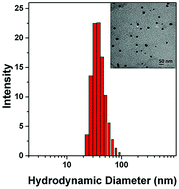Our official English website, www.x-mol.net, welcomes your
feedback! (Note: you will need to create a separate account there.)
Fluorescence resonance energy transfer (FRET) based nanoparticles composed of AIE luminogens and NIR dyes with enhanced three-photon near-infrared emission for in vivo brain angiography†
Nanoscale ( IF 5.8 ) Pub Date : 2018-04-26 00:00:00 , DOI: 10.1039/c8nr00066b Wen Liu 1, 2, 3, 4, 5 , Yalun Wang 1, 2, 3, 4, 5 , Xiao Han 5, 6, 7, 8 , Ping Lu 5, 6, 7, 8 , Liang Zhu 3, 4, 5, 9 , Chaowei Sun 1, 2, 3, 4, 5 , Jun Qian 1, 2, 3, 4, 5 , Sailing He 1, 2, 3, 4, 5
Nanoscale ( IF 5.8 ) Pub Date : 2018-04-26 00:00:00 , DOI: 10.1039/c8nr00066b Wen Liu 1, 2, 3, 4, 5 , Yalun Wang 1, 2, 3, 4, 5 , Xiao Han 5, 6, 7, 8 , Ping Lu 5, 6, 7, 8 , Liang Zhu 3, 4, 5, 9 , Chaowei Sun 1, 2, 3, 4, 5 , Jun Qian 1, 2, 3, 4, 5 , Sailing He 1, 2, 3, 4, 5
Affiliation

|
Near-infrared (NIR) fluorescence is very important for high-contrast biological imaging of high-scattering tissues such as brain tissue. Unfortunately, commercial NIR dyes are excited usually by visible light, and their multi-photon absorption (MPA) cross-sections are small. Here, we design new co-encapsulated NIR nanoparticles (NPs) with a large three-photon (3PA) absorption cross-section. A form of aggregation-induced emission (AIE) luminogen (AIEgen), 2,3-bis(4′-(diphenylamino)-[1,1′-biphenyl]-4-yl) fumaronitrile (TPATCN), is introduced as the donor, and a form of NIR dye, silicon 2,3-naphthalocyanine bis-(trihexylsilyloxide) (NIR775), is adopted as the acceptor. Under the excitation of a 1550 nm fs laser, TPATCN–NIR775 NPs demonstrated a bright three-photon fluorescence centered at 785 nm. The energy transfer efficiency of the TPATCN–NIR775 NPs was calculated to be as high as 90%, which could be attributed to the good spectral overlap between the emission of TPATCN and the absorption of NIR775. By injection with TPATCN–NIR775 NPs, a vivid 3D reconstruction of mouse brain vasculature was obtained with even small blood vessels clearly visualized. The design strategy used for the co-encapsulated AIE–NIR NPs would be helpful in synthesizing more NIR probes for deep-tissue biological imaging in the future.
中文翻译:

基于荧光共振能量转移(FRET)的纳米粒子,由增强型三光子近红外发射的AIE发光剂和NIR染料组成,用于体内脑血管造影†
近红外(NIR)荧光对于诸如脑组织等高散射组织的高对比度生物成像非常重要。不幸的是,商业NIR染料通常被可见光激发,并且它们的多光子吸收(MPA)截面很小。在这里,我们设计了具有大三光子(3PA)吸收截面的新型共封装NIR纳米颗粒(NP)。介绍了一种聚集诱导发射(AIE)发光剂(AIEgen)的形式,即2,3-双(4'-(二苯氨基)-[1,1'-联苯] -4-基)富马腈(TPATCN)。作为供体,采用NIR染料形式的2,3-萘菁硅双-(三己基甲硅烷基氧化物)硅(NIR775)作为受体。在1550 nm fs激光的激发下,TPATCN–NIR775 NP表现出以785 nm为中心的明亮的三光子荧光。TPATCN–NIR775 NP的能量转移效率经计算可高达90%,这可能是由于TPATCN的发射与NIR775的吸收之间存在良好的光谱重叠。通过注射TPATCN-NIR775 NP,即使是清晰可见的小血管也能获得生动的小鼠脑血管3D重建。用于共包封的AIE–NIR NP的设计策略将有助于将来合成更多用于深层组织生物成像的NIR探针。
更新日期:2018-04-26
中文翻译:

基于荧光共振能量转移(FRET)的纳米粒子,由增强型三光子近红外发射的AIE发光剂和NIR染料组成,用于体内脑血管造影†
近红外(NIR)荧光对于诸如脑组织等高散射组织的高对比度生物成像非常重要。不幸的是,商业NIR染料通常被可见光激发,并且它们的多光子吸收(MPA)截面很小。在这里,我们设计了具有大三光子(3PA)吸收截面的新型共封装NIR纳米颗粒(NP)。介绍了一种聚集诱导发射(AIE)发光剂(AIEgen)的形式,即2,3-双(4'-(二苯氨基)-[1,1'-联苯] -4-基)富马腈(TPATCN)。作为供体,采用NIR染料形式的2,3-萘菁硅双-(三己基甲硅烷基氧化物)硅(NIR775)作为受体。在1550 nm fs激光的激发下,TPATCN–NIR775 NP表现出以785 nm为中心的明亮的三光子荧光。TPATCN–NIR775 NP的能量转移效率经计算可高达90%,这可能是由于TPATCN的发射与NIR775的吸收之间存在良好的光谱重叠。通过注射TPATCN-NIR775 NP,即使是清晰可见的小血管也能获得生动的小鼠脑血管3D重建。用于共包封的AIE–NIR NP的设计策略将有助于将来合成更多用于深层组织生物成像的NIR探针。











































 京公网安备 11010802027423号
京公网安备 11010802027423号